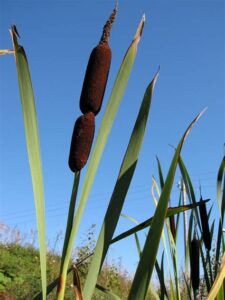By Wendy Petty
Cattails have been described as the grocery store of the wild because every part of the plant is edible. During the growing season, three of these parts — shoots, flowers and pollen — provide easily accessed and versatile food for foragers.
Better yet, these parts of the cattail offer analogs to familiar flavors such as cucumber and corn, which means that even those dubious of wild food might enjoy them. Euell Gibbons treasured cattails, “For the number of different kinds of food it produces there is no plant, wild or domesticated, which tops the common cattail.”
Sometimes growing 9 feet tall and best recognized in late summer by their brown cigar-shaped flowers, both broadleaf (Typha latifolia) and narrow-leaf cattail (T. angustifolia) are edible, and can be used interchangeably. Though widely available, care must be taken to harvest cattail from a clean location because the plant grows in marshy areas, which can be contaminated.
Whether you live in the city or the country, use caution when choosing a place to pick cattails, particularly cattail shoots. Consider what the water looks and smells like where you are harvesting, as well as what may be upstream. In the city, drainage from streets and golf courses can make water unsafe for collecting food. Rural locations can look pristine, but beware of agricultural runoff.
Finding the right place to forage
Perhaps the best known edible part of cattail, the tender core of the growing leaves, is commonly referred to as the shoot. Cattail shoots are best before the plant begins to flower. To harvest cattail shoots, peel back the outer two or three leaves, firmly grasp the remaining leaves with both hands, and give the plant a tug. You will have in your hands something that looks like an enormous leek.

Peel back more leaves until the lower end is a creamy pale white. Cut off all of the dark green leaves so that you are left with a heart of cattail. If you feel certain you have harvested your cattail shoots from a clean location, do a taste test.
Some people feel a scratchy sensation at the back of the throat when eating raw cattails. If so, skip eating them raw. If you don’t feel the itchy sensation, delight in the crunchy and satisfyingly cucumber taste of cattail shoots. They can be used in all the dishes for which you’d traditionally use cucumber, from salad to tzatziki to refreshing yogurt soup.
Making the most of cattail shoots
Cattail shoots are also fantastic when cooked. They can simply be chopped and added to stir-fries and side dishes. They are especially good when blanched, dressed in oil, garlic, salt and pepper, and lightly grilled.
When cattail flowers emerge, they are well disguised by sheaths of leaves, much like slender ears of corn. Cattail flowers are made up of two parts. The upper portion is male and will go on to produce pollen. The lower portion is female and is what remains and turns into the recognizable brown sausage-shaped punk later in the year.
In narrow-leaf cattail, the male and female portion are separated by a small bit of spike, whereas the broad-leaf cattail, the two bits are connected. The upper, male, portion of the cattail flower is what is traditionally harvested, as it provides a greater amount of edible material than the female bit.
Cattail flowers — just like corn on the cob
Look to collect cattail flowers as they begin to emerge from their sheath, and simply cut the upper portion off with a pair of scissors or a knife.
To enjoy cattail flowers, steam them whole for 10 minutes. If you have children around, they may enjoy eating the cooked cattail flowers with a bit of butter and salt, like miniature corn-on-the-cob, though care must be taken not to ingest the inedible toothpick-like core of cattail flowers.
Cattail flowers may also be stripped off their inner core using an upside down fork. Using this method, it is quite simple to prepare a large amount of flowers in a short period of time.
Cattail flowers have a surprisingly sweet and mellow flavor, not unlike corn. They may be prepared simply, with nothing more than garlic butter and salt. Cattail flowers also work well in egg dishes and soups.
The special treat of cattail pollen
Perhaps the most delightful part of the cattail to eat is its bright yellow pollen.
Look for cattail flowers that are loaded with yellow pollen, like a mop heavy with dust, and collect it by shaking the top portion of the cattail flower into a milk jug or half-gallon Mason jar, either in the field or snipped off and done at home.
Cattail pollen can be substituted into 1/3 of the flour in most recipes for baked goods, from pancakes to muffins and breads. Cattail pollen can also be used to add a sunny color and subtle milky corn flavor to rice dishes.
Copyright 2016 Wendy Petty via Zester Daily and Reuters Media Express

